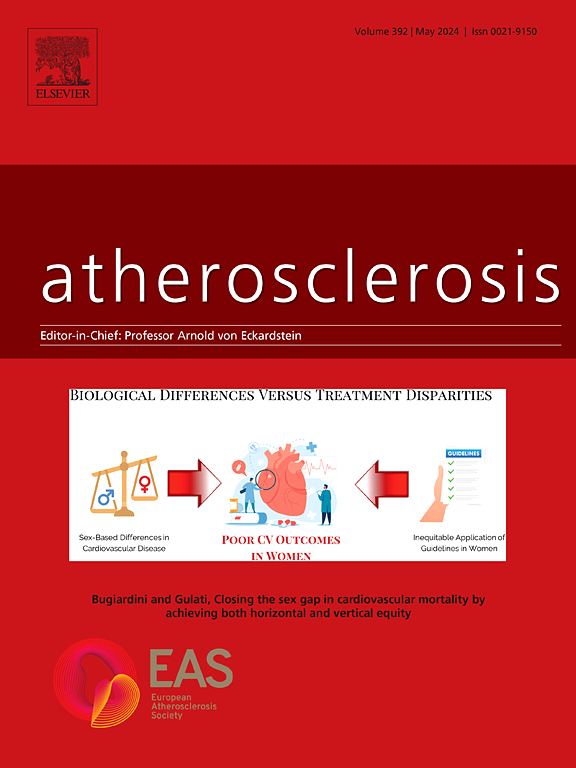Simvastatin ameliorates senescence-induced mitochondrial dysfunction in vascular smooth muscle cells
IF 4.9
2区 医学
Q1 CARDIAC & CARDIOVASCULAR SYSTEMS
引用次数: 0
Abstract
Background and aims
Senescence and mitochondrial dysfunction are two major indicators of aging. Mitochondria are potential drivers of aging phenotypes and dysfunctional mitochondria are associated with several age-related diseases. There is evidence that senescence induces changes in mitochondrial structure, dynamics, and function. Moreover, senescent vascular smooth muscle cells (VSMCs) are present in atherosclerotic plaques and contribute to their instability. The anti-atherosclerotic effects of simvastatin are well known, but recently other benefits, such as promoting mitochondrial quality and senostatic effects, have been hypothesized. We aimed to analyze simvastatin's senostatic effects in senescent VSMCs.
Methods
We established and characterized mitochondrial dysfunction in doxorubicin-induced senescent VSMCs (doxorubicin) or VSMCs serially passaged to induce replicative senescence (old).
Results
We observed in both senescent models few typical senescence markers such as altered cell morphology, cell cycle inhibitors, laminB1, an accumulation of dysfunctional mitochondria characterized by reduced mitochondrial membrane potential (MMP) and respiration, accumulation of reactive oxygen species (ROS), and an altered mitochondria morphology. Down-regulation of TFAM and TOM70 expression was observed only in old cells suggesting a reduction of mitochondrial biogenesis. Next, we investigated whether simvastatin could ameliorate age‐associated phenotypes in senescent VSMCs. Simvastatin 0.1 μM reduces the senescence-associated secretory phenotype (SASP) and ROS production and improves mitochondrial respiration in doxorubicin and old VSMCs. Interestingly, the effects of simvastatin on mitochondrial respiration and SASP were replicated by using a siRNA for the hydroxy-methyl-glutaryl-coenzyme A (HMG-CoA) reductase, and abolished by adding mevalonic acid, suggesting that these effects are mediated through the inhibition of HMG-CoA reductase.
Conclusions
Our results suggest that simvastatin controls SASP and exerts potentially beneficial therapeutic effects by ameliorating senescence-induced mitochondrial dysfunction in senescent VSMCs.

辛伐他汀改善衰老诱导的血管平滑肌细胞线粒体功能障碍
背景与目的衰老和线粒体功能障碍是衰老的两大主要指标。线粒体是衰老表型的潜在驱动因素,功能失调的线粒体与几种与年龄相关的疾病有关。有证据表明,衰老引起线粒体结构、动力学和功能的变化。此外,衰老的血管平滑肌细胞(VSMCs)存在于动脉粥样硬化斑块中,并有助于其不稳定性。辛伐他汀的抗动脉粥样硬化作用是众所周知的,但最近其他的好处,如提高线粒体质量和静态效应,已经假设。我们的目的是分析辛伐他汀对衰老VSMCs的静感作用。方法建立并表征阿霉素诱导的衰老VSMCs(阿霉素)或连续传代诱导复制性衰老的VSMCs的线粒体功能障碍。结果在两种衰老模型中,我们观察到一些典型的衰老标志物,如细胞形态改变,细胞周期抑制剂,层压蛋白b1,功能失调线粒体的积累,其特征是线粒体膜电位(MMP)和呼吸减少,活性氧(ROS)的积累,以及线粒体形态的改变。TFAM和TOM70表达下调仅在老年细胞中观察到,表明线粒体生物发生减少。接下来,我们研究了辛伐他汀是否可以改善衰老VSMCs中年龄相关的表型。辛伐他汀0.1 μM可降低阿霉素和老年VSMCs的衰老相关分泌表型(SASP)和ROS的产生,并改善线粒体呼吸。有趣的是,辛伐他汀对线粒体呼吸和SASP的影响可以通过羟甲基戊二酰辅酶a (HMG-CoA)还原酶的siRNA复制,并通过添加甲羟戊二酸消除,这表明这些影响是通过抑制HMG-CoA还原酶介导的。结论辛伐他汀可控制SASP,并通过改善衰老引起的VSMCs线粒体功能障碍发挥潜在的有益治疗作用。
本文章由计算机程序翻译,如有差异,请以英文原文为准。
求助全文
约1分钟内获得全文
求助全文
来源期刊

Atherosclerosis
医学-外周血管病
CiteScore
9.80
自引率
3.80%
发文量
1269
审稿时长
36 days
期刊介绍:
Atherosclerosis has an open access mirror journal Atherosclerosis: X, sharing the same aims and scope, editorial team, submission system and rigorous peer review.
Atherosclerosis brings together, from all sources, papers concerned with investigation on atherosclerosis, its risk factors and clinical manifestations. Atherosclerosis covers basic and translational, clinical and population research approaches to arterial and vascular biology and disease, as well as their risk factors including: disturbances of lipid and lipoprotein metabolism, diabetes and hypertension, thrombosis, and inflammation. The Editors are interested in original or review papers dealing with the pathogenesis, environmental, genetic and epigenetic basis, diagnosis or treatment of atherosclerosis and related diseases as well as their risk factors.
 求助内容:
求助内容: 应助结果提醒方式:
应助结果提醒方式:


